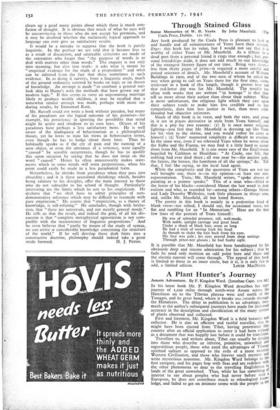Through Stained Glass
Some Memories of W. B. Yeats. By John Masefield. (Tye Cuala Press, Dublin. izs. 6d.) ANY book produced by the Cuala Press is pleasant to look at and handle and all reminiscences of Yeats have their interest. Ergo: this book has its value, but I would not say that it is worthy of either Yeats or Mr. Masefield. As a tribute to a dead' poet from a personal friend it rings true enough ; but, per- sonal friendships aside, it does not add much to. our knowledge of the strangest literary figure of our time. - Being very shoe- less than thirty pages of print—it required a more careful and poised selection of details. Mr. Masefield's account of Woburn Buildings in 1900, and of the two men of whom he asked the way when going to call on Yeats there for the first time, seems irrelevant in a book of this length, though it proves how red that red-letter day was for Mr. Masefield. The trouble too often with works that are written " in homage " is that they tell us more about their author than about their subject. What is more unfortunate, the religious light which they cast upon their subject tends to make him less credible and so less sympathetic, does him less justice in fact, than more cold- blooded but objective estimates.
Much of this book is in verse, and both the verse and prose in it are in places derivative in style from Yeats himself, and this is a pity for two reasons : (t) It is once more religious lighting—you feel that Mr. Masefield is dressing up like Yeats for his visit to the shrine, and you would rather he came as himself ; (2) Yeats' mannered simplicity is difficult to emulate. In the same way, even if we tolerated Yeats when he wrote about the Sidhe and the Fianna, we may find it a little hard to accept them from Mr. Masefield. It is one more case of the Englishman beguiled by Cathleen ni Houlihan: " At Coole, one felt, that nothing had ever died there ; all was near by—the ancient gods, the fairies, the heroes, the hawthorn of all the springs," &c. Tell that, I feel like saying, to the local land agent.
While the complexity and the queerness of Yeats are not too well brought out, there is—in my opinion—at least one mis- representation. Yeats,' Mr. Masefield writes, " spoke always of painting as a painter speaks." This of a man who—blind to the lustre of his blacks—considered Manet the last word in drab realism and who, as recorded by—among others—George Moore and Lady Dorothy Wellesley, took little pleasure in things seen, and, unlike Mr. Masefield, all but hated flowers.
The poetry in this book is mainly in a pedestrian kind of blank verse—too stilted, I should say, for occasional verse, too flat and rambling for an " In Memoriam." Here are the first few lines of the portrait of Yeats himself : He was of splendid presence, tall, well-made,
With noble, upright carriage and great head
Under a shock of black hair, worn so long He had a trick of tossing back his head As though to shake the hair back from his eyes. His face was pale ; his eyes peered from deep settings Through pince-nez glasses ; he had faulty sight.
It is possible that Mr. Masefield has been handicapped by his obviously deep and sincere admiration for his subject • that he feels he need only mention an odd point here and there and the electric current will come through. The appeal of this book is limited to those in an inner circle, but it is, it is only fair to






























 Previous page
Previous page